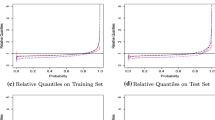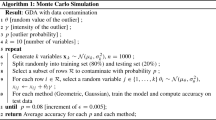Abstract
In this paper a brief review of the main contributions to projection pursuit discriminant analysis is presented. A new procedure, based on distance measures between probability densities, is developed in order to obtain linear discriminant functions, which best separate different populations. In the two- group case, Matusita’s distance between the projected population density functions is adopted as projection index; while, in the multi-group case, a monotone transformation of Matusita’s affinity coefficient is employed to measure the separation among the marginal probability density functions of the different populations. Simulation studies stress the efficacy of the proposed method in comparison with classical parametric ones and with the projection pursuit based linear discriminant procedure developed by Posse.
Access this chapter
Tax calculation will be finalised at checkout
Purchases are for personal use only
Preview
Unable to display preview. Download preview PDF.
Similar content being viewed by others
References
Bhattacharyya, A. (1943). On a measure of divergence between two statistical populations defined by their probability distributions, Bulletin of the Calcutta Mathematical Society, 35, 99–109.
Calò, D. & Montanari, A. (1997). An empirical discrimination algorithm based on projection pursuit density estimation, Book of Short Papers, Classification and Data Analysis, Meeting of the Classification Group of Società Italiana di Statistica, Pescara, 3-4 luglio, 65–68.
Chen, Z. & Muirhead, R.J. (1994). A comparison of robust linear discriminant procedures using projection pursuit methods, in Multivariate Analysis and its Applications, IMS Lecture Notes-Monograph Series, Hayward, 24, 163–176.
Flick, T.E. & Jones, L.K. & Priest, R.G. & Herman, N.C. (1990). Pattern classification using projection pursuit, Pattern Recognition, 12, 1367–1376.
Friedman, J.H. (1985). Classification and multiple regression through projection pursuit, Technical Report 12, Laboratory for Computational Statistics, Department of Statistics, Stanford University.
Friedman, J.H. & Tukey, J. (1974). A projection pursuit algorithm for exploratory data analysis, IEEE Transactions on Computers, 23, 881–889.
Glick, N. (1973). Separation and probability of correct classification among two or more distributions, Annals of the Institute of Statistical Mathematics, 25, 373–382.
Henry, D.H. (1983). Multiplicative models in projection pursuit, Ph. D. Thesis, Stanford Linear Accelerator Center, Stanford University.
Huber, P.J. (1985). Projection pursuit, The Annals of Statistics, 13, 435–475.
Huber, P.J. (1990). Algorithms for projection pursuit, Technical Report 3, Department of Mathematics, M.I.T. Cambridge.
Krzanowski, W.J. (1988). Principles of multivariate analysis, Oxford Science Publication, New York, 359–360.
Matusita, K. (1956). Decision rule, based on distance, for the classification problem, Annals of the Institute of Statistical Mathematics, 8, 67–77.
Matusita, K. (1967). On the notion of affinity of several distributions and some of its applications, Annals of the Institute of Statistical Mathematics, 19, 181–192.
Montanari, A. & Lizzani, L. (1996). Projection pursuit e scelta delle variabili, Atti della XXXVIII Riunione Scientifica della Società Italiana di Statistica, 2, 591–598.
Polzehl, J. (1995). Projection pursuit discriminant analysis, Computational Statistics and Data Analysis, 20, 141–157.
Posse, C. (1992). Projection pursuit discriminant analysis for two groups, Communications in Statistics - Theory and Methods, 21, 1–19.
Roosen, C.B. & Hastie, T.J. (1993). Logistic response projection pursuit regression, Statistics and Data Analysis Research Department, AT&T Bell Laboratories, Doc. BL011214-930806-09TM.
Sheather, S.J. & Jones, M.C. (1991). A reliable data-based bandwidth selection method for kernel density estimation, Journal of the Royal Statistical Society, Series B, 93, 683–690.
Silverman, B.W. (1986). Density estimation for statistics and data analysis, Chapman and Hall, London.
Author information
Authors and Affiliations
Editor information
Editors and Affiliations
Rights and permissions
Copyright information
© 1998 Springer-Verlag Berlin · Heidelberg
About this paper
Cite this paper
Lizzani, L. (1998). A Density Distance Based Approach to Projection Pursuit Discriminant Analysis. In: Rizzi, A., Vichi, M., Bock, HH. (eds) Advances in Data Science and Classification. Studies in Classification, Data Analysis, and Knowledge Organization. Springer, Berlin, Heidelberg. https://doi.org/10.1007/978-3-642-72253-0_34
Download citation
DOI: https://doi.org/10.1007/978-3-642-72253-0_34
Publisher Name: Springer, Berlin, Heidelberg
Print ISBN: 978-3-540-64641-9
Online ISBN: 978-3-642-72253-0
eBook Packages: Springer Book Archive




